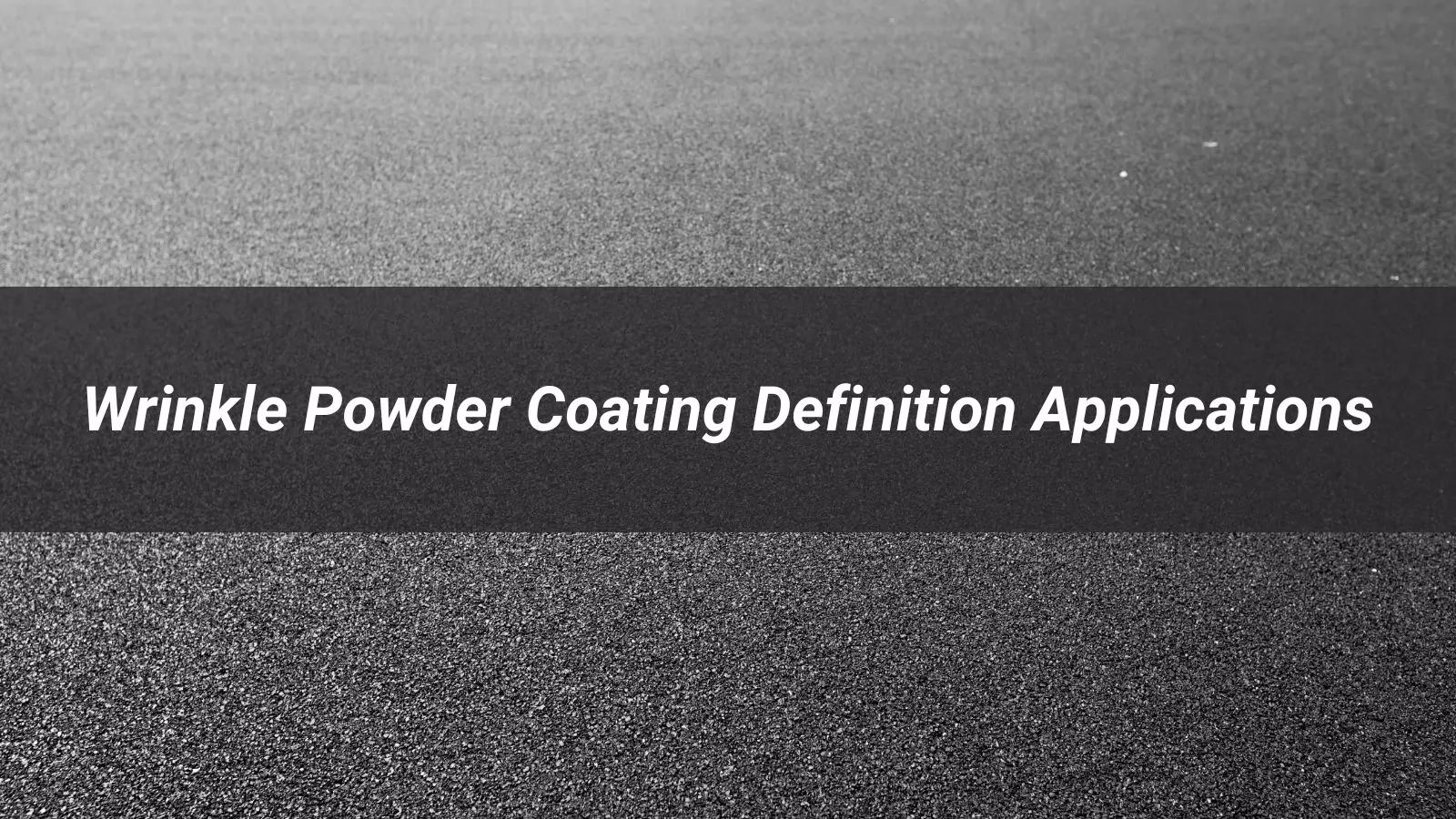
.png)

.png)
.png)


-
.png) 0086-757-85407388
0086-757-85407388 -

-
 terrychen@wintoly.com
terrychen@wintoly.com


.png)

.png)
.png)


.png)




Wrinkle powder coating is a specialized type of dry finishing process that produces a distinctive textured, wrinkled surface on coated substrates. Known for its unique aesthetic appeal and functional properties, this coating is widely used across various industries for both decorative and protective purposes. Unlike smooth powder coatings, wrinkle powder coatings create a crackled or rippled finish, offering enhanced durability, grip, and the ability to conceal surface imperfections. This article explores the definition, characteristics, application process, and uses of wrinkle powder coating, highlighting its significance in modern manufacturing.
Powder coating is a dry finishing technique where finely ground particles of pigment and resin are electrostatically charged and sprayed onto a grounded substrate, typically metal, before being cured in an oven to form a hard, protective layer. Wrinkle powder coating is a subset of this process, formulated to produce a textured, wrinkled appearance during the curing phase. The texture results from specific chemical compositions and curing conditions that cause the coating to contract and form irregular patterns as it solidifies.
Wrinkle powder coatings are typically thermoset, meaning they undergo an irreversible chemical cross-linking reaction during curing, resulting in a durable, heat-stable finish. The coating is composed of polymer resins, pigments, curing agents, and additives, with the resin type—often polyester or epoxy-polyester hybrids—playing a critical role in achieving the desired texture. The wrinkled effect is controlled by factors such as film thickness, curing temperature, and application technique, making it a highly customizable finish.
Wrinkle powder coatings are distinguished by their unique properties, which contribute to their popularity in various applications:
Textured Appearance: The coating forms a wrinkled, crackled, or rippled surface, adding visual depth and a tactile feel that enhances aesthetic appeal.
Durability: The thermoset nature of the coating provides excellent resistance to scratches, impacts, abrasion, and chemical corrosion, making it suitable for demanding environments.
Surface Imperfection Concealment: The textured finish effectively hides minor scratches, dents, or uneven surfaces, reducing the need for extensive surface preparation.
Anti-Slip Properties: The rough texture increases surface friction, improving grip and making it ideal for safety applications like handrails or tools.
Anti-Fingerprint and Easy to Clean: The wrinkled surface minimizes the visibility of fingerprints and smudges, simplifying maintenance for high-contact items.
Environmental Benefits: As a solvent-free process, wrinkle powder coating emits negligible volatile organic compounds (VOCs), aligning with environmental regulations and promoting sustainability.
Available in single-tone colors, often with metallic additives for enhanced shine, black wrinkle powder coating is particularly popular due to its sleek, versatile look.
The application of wrinkle powder coating involves a series of precise steps to ensure a consistent, high-quality finish:
Surface Preparation: The substrate, typically metal, is cleaned to remove grease, dust, rust, or oils. Techniques such as abrasive blasting, chemical pretreatment (e.g., phosphating), or plasma treatment for non-metallic surfaces ensure proper adhesion. Thorough preparation is critical to avoid defects like bubbling or poor adhesion.
Powder Application: The wrinkle powder is applied using an electrostatic spray gun, which charges the powder particles as they are sprayed onto a grounded substrate. The electrostatic attraction ensures even coverage. Film thickness is carefully monitored, as it significantly affects the development of the wrinkled texture. Too thin or too thick a layer can result in a smooth or inconsistent finish.
Curing: The coated substrate is placed in an oven, typically at temperatures between 110–250°C, for 10–30 minutes, depending on the substrate and powder formulation. During curing, the powder melts, flows, and undergoes a chemical reaction to form the wrinkled texture. Proper curing temperature and dwell time are essential, as under-curing can lead to glossy or smooth patches, while over-curing may enhance texture consistency.
Cooling and Inspection: After curing, the substrate is cooled, and the coating is inspected for uniformity, texture consistency, and adhesion. Any defects, such as adhesion issues or contamination, may require re-coating or stripping.
Key factors influencing the wrinkle pattern include film thickness, part cure temperature, bring-up time (how quickly the part reaches curing temperature), and hanging/racking methods. For example, uneven heating due to part geometry or improper racking can lead to inconsistent textures.
Wrinkle powder coating is valued for its combination of aesthetic appeal and functional benefits, making it a versatile choice across multiple industries. Common applications include:
Automotive Parts: Used on underbody and underhood components, such as valve covers, bash bars, or alloy wheels, for corrosion resistance and a rugged, textured look. Black wrinkle finishes are particularly popular in automotive applications.
Furniture and Decorations: Metal furniture, such as outdoor tables or chairs, benefits from the coating’s UV resistance, durability, and ability to hide surface flaws. The textured finish adds a premium, tactile quality to interior décor items.
Electronic Equipment: Applied to laptop housings, mobile phone accessories, or electrical enclosures to enhance wear resistance, reduce fingerprints, and provide a distinctive appearance.
Industrial Equipment: Coated onto machinery, toolboxes, and shelving to withstand harsh environments, resist chemical exposure, and improve grip for handling.
Sports and Recreation: Used on gym equipment, bicycle frames, and safety gear for added grip, durability, and a unique aesthetic that conceals wear and tear.
Hardware and Tools: Hand tools, power tools, and fixtures are coated to improve grip, resist abrasion, and maintain a professional appearance under frequent use.
Architectural Elements: Handrails, fences, and outdoor fixtures leverage the coating’s anti-slip properties and weather resistance, with black wrinkle finishes offering a modern, industrial look.
The coating’s ability to be applied over existing powder coatings, provided compatibility and surface preparation are ensured, also makes it suitable for refurbishing older equipment or furniture.
While wrinkle powder coating offers numerous advantages, achieving a consistent finish requires careful control. Common challenges include:
Inconsistent Texture: Variations in film thickness, curing temperature, or part geometry can lead to smooth or uneven wrinkles. Preheating the substrate or adjusting oven settings can mitigate this.
Adhesion Issues: Poor surface preparation or incompatible base coats can cause peeling or flaking. For example, applying a top coat over an under-cured base coat may result in unintended textures.
Contamination: Dust, oil, or incompatible powders can disrupt the wrinkle pattern, necessitating rigorous cleaning and quality control.
Curing Precision: Under-curing often produces glossy or smooth areas, while over-curing may be preferable to ensure texture development. Operators must follow the powder manufacturer’s curing guidelines.
To address these challenges, manufacturers often create proprietary visual standards for the wrinkle pattern, as no universal standards exist for texture consistency. Test panels coated under controlled conditions can serve as benchmarks for quality assurance.
Wrinkle powder coating is a dynamic finishing solution that combines aesthetic versatility with robust functional properties. Its distinctive textured appearance, durability, and ability to hide imperfections make it a preferred choice for automotive, furniture, industrial, and architectural applications. By leveraging precise application techniques and curing conditions, manufacturers can achieve consistent, high-quality finishes that enhance product longevity and appeal. As industries continue to prioritize eco-friendly and durable coatings, wrinkle powder coating stands out as a sustainable, high-performance option, offering endless possibilities for innovation in surface treatment.

 terrychen@wintoly.com
terrychen@wintoly.com
.png) 0086-757-85407388
0086-757-85407388
 6 Chaoyang Rd., National Demonstration Eco-industrialzone, Nanhai, Foshan,Guangdong,China
6 Chaoyang Rd., National Demonstration Eco-industrialzone, Nanhai, Foshan,Guangdong,China

.png)
